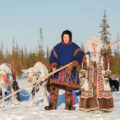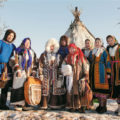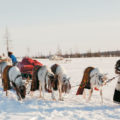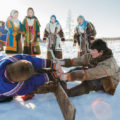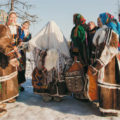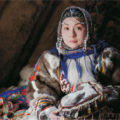The celebratory traditions of the indigenous people of the far north
Russia’s indigenous ethnic groups carefully preserve their national traditions by passing down family rites and customs through the generations . One of these unique rites is the Nenets marriage ritual.
There are two large groups of the Nenets people, the Forest Nenets and Tundra Nenets. Despite the vast territories that they inhabit, stretching from the White Sea to the lower reaches of the Yenisei river, all Tundra Nenets share the same culture. The main elements of the traditional wedding ritual are the same for all Nenets, but of course there were differences depending on the area, the wealth of the family and the traditions of the specific clan.
Exogamous norms were of first to be considered when concluding marriages: marriages could happen only between representatives of different clans. Economic factors were also important, as well as personal qualities of the bride: her health, ability to work, and skills.
The offer of marriage
Marriage by offer used to be, and sometimes still is, the main form of marriage among the Nenets people. After laying his eyes on a girl, a young man together with his relatives sat down for a family council, where they discussed the qualities of the girl and chose a marriage broker. In some cases, the groom’s mother could act as the marriage broker herself.
On a set day, the groom and the marriage broker went to the camp of the bride’s family. They approached the tent, also called a ‘chum’, where father of the bride lived, and the marriage broker went inside to announce the purpose of his or her arrival. The main tool of the marriage broker was his staff. Usually the marriage broker began by saying to the bride’s father: “Is your daughter at home or not”?
If the girl’s father did not want his daughter to marry that man for some reason, he would not respond to the proposal or asked for a huge bridewealth.
If the father liked the groom, he started negotiating the amount of bridewealth with the marriage broker: the bride’s father made cuts on the staff corresponding to the number of deer he requests.
Having agreed on the bridewealth, the marriage broker left the staff which was later kept by the bride’s father in the sacred sledge. The number of such staffs was equal to the number of married daughters. When the family received several deer as advance, the marriage was considered arranged. The date of the wedding depended on the payment and the availability of the dowry.
The bridewealth was usually paid before the wedding, and its amount depended on the groom’s wealth. The bulk of it was made up of deer, the rest was fur, cloth, etc. A large bridewealth increased the status of the bride.
At the bride’s tent
For the bride, the wedding day preparations began with a bath and ritual cleansing with smoke. Then her hair was styled: the bride’s braids were decorated with jewellery, and she put on a special piece of headgear called “sudyr”. The important accessory were long fake braids. Nenets people had no special wedding clothes, so the bride wore her most elegant and new clothes made of the best-quality skins.
On the set day, the groom and his relatives put on their best clothes and went to the bride’s tent. The wedding argish — a caravan of several deer sleds going one after another — could be a whole kilometre long.
Once he arrived to the bride’s tent, the groom would drive the sledge three times around it sun-wise, and after that the bride’s family who stood outside the tent rushed to catch the marriage broker, the groom and all other guests. The goal of the bride’s family was to catch all sledges riding at full speed.
Having caught one of the men, they would jokingly tie him to a sledge in the back of the tent, and women were tied to the sledge at the entrance. Their deer were unharnessed and release to graze freely. This was a reminiscence of the fights that happened long time ago when the groom tried to take the bride.
On the first day of the wedding, a deer was sacrificed. To bring luck to the newlyweds, the bride’s shawl and the groom’s lasso rope were passed three times around the neck of the sacrificial deer with wishes of a happy family life. Together with the newlyweds, all other people passed three times under the lasso rope that was tied to the deer’s neck.
The meat of such deer was considered sacred, it could not be brought into the tent and the guests had to eat it raw. Separate organs of the sacrificial animals were also assigned magical properties and were used as amulets. Thus, the tip of the stag’s left ear was used to draw a strip on the foreheads of the bride and groom.
The mother of the bride invited the groom’s family to the tent that was locked from the inside. The groom’s task was to slip a red cloth inside the tent, and the bride’s relatives tried to prevent him from doing that. When the cloth was finally pushed inside, it was then cut into strips and distributed to the women who defended the doors and to all members of the bride’s family.
After receiving payment for entering the door, the bride’s mother invited everyone to eat the freshly-killed deer. The treat was held outside. It was believed that home and family spirits from the sacred sledge also took part in the feast. Then the festive tables were set inside the tent. The usual treats were raw and boiled meat, fish, and soup.
Once they were done with the first set of meal at the wedding table, everyone came outside to take part in games and competitions, while dinner was being prepared inside the tent. The bride and the groom were served boiled heart and tongue of a deer: this ritual dish meant that now they had one heart and one tongue.
The bride departed for the groom’s tent the next morning. There was a ritual aimed at increasing the chances of the new family for having a baby — a small child was placed in the bride’s sledge so that the female sledge would never be empty.
Outside of the exit from the tent, the blood of the sacred deer was poured out of a vessel to make a puddle. The bride was led out of the tent and she stepped over a bloody puddle, thus protecting the entrance to her parents’ house from dark forces. The bride was placed in the female sledge and covered tightly with a cloth by the groom’s family. Father then said his goodbyes and best wishes: “You are no longer our daughter, you are married. Live well with your husband, love him and listen to all your elders”. The bride’s sledge was decorated with elegant harness, jingles and sleigh-bells.
Every bride was given dowry that formed the basis of the young family’s household. Brides from wealthy families received from their parents a tent and a whole argish made of several deer sleds. A necessary part of the bride’s dowry was a new chintz bed curtain, because married life for Nenets people began under the bed curtain. It was the only thing that separates the bed of the couple from that of the rest of the family.
The bride’s sledge was tied to that of the marriage broker’s wife or the groom’s mother. Before the departure of the bride to the groom’s tent, her argish was escorted three times around her parent’s home.
The argish headed east and passed under the ritual gate that had been built by the bride’s father before the groom’s guests arrived. This gate was a symbolic border between families or clans that the bride crossed when entering her husband’s clan.
At the groom’s tent
Upon arrival at the camp, the wedding argish drove three times around the groom’s tent. The marriage broker brought the bride into the tent and uncovered her face. The groom unharnessed the deer and neatly folded all the harnesses in his sledge. If some item from the harnessing gear was left on the ground or was folded carelessly, it meant that the groom was reluctant to take this girl as his wife and simply obeyed the orders of his parents.
The same things usually happened at the groom’s camp as at the bride’s: the deer sacrifice, a treat in front of the tent, then dinner inside the tent, and then games and contests.
According to the Nenets tradition, the mother of the groom prepares the bed for the newlyweds. The newlyweds’ bed was separated by the bed curtain from the bride’s dowry. When the curtain was lowered, it symbolized that the groom and the bride finally became husband and wife. It was the culmination of the wedding — the bride finally cut her ties with her father’s clan and receives the status of a married woman in the husband’s family.
In the morning, the young wife began her duties: she made fire at the hearth, prepared meals, treated guests. From that moment, the young woman began a new life. The bride’s parents said goodbye to their daughter, then to the groom’s parents. The guests packed gifts from the groom’s family in their sledge and left.
Post-wedding rites
One or two days later, the young couple made a visit to the bride’s parents. The young husband brought seven deer as a gift to the bride’s father, these deer were to be harnessed to the sacred sledge. Before the departure, the father of the bride slaughtered a deer and served the meat to the departing guests. At least a year would pass before the daughter sees her parents again. Every year, when visiting her parents, the married daughter receives valuable gifts such as a deer or a new fur coat.
The traditional wedding ritual shows that marriage was very important for the Nenets people. A new family was formed, a married son could separate and live in his own household, and the birth of children, especially sons, raised his social status: his sons would continue the family line.
Denis Knyazev, founder of “Marriages of the peoples of the world: Cultural heritage” project
Galina Kharyuchi, Cand.Sc.(History), author of monographs on history and culture of the Nenets people

